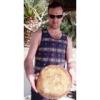
Double Pains de Campagne, Olive Levain and a “Hardcore Borodinsky”
Double Pains de Campagne, Olive Levain and a “Hardcore Borodinsky”
One large Boule, proved in a banneton, of just over 1300g, and one of 700g, proved in a brotform.
Olive Levain takes its inspiration from the Hamelman (2004) version on pp. 178 – 179, but with changes sufficient for me to feel happy publishing the formula and method I have devised.
As if Borodinsky isn’t hardcore with an 80:20 Rye: Wheat mix, this is all Dark Rye Flour!
Here’s the detail of the leaven refreshment used for the stiff levain used in the Pain de Campagne and Olive Levain. Bonus of being able to make a couple of Naan breads with the leaven after first build to accompany yesterday’s evening meal of saag dal and aloo gobhi and brinjal curry.
Material | Recipe [grams] |
1. Leaven Build One [Friday; 19:00] |
|
Leaven from Stock | 80 [50 flour: 30 water] |
Marriage’s Organic Strong White Flour | 100 |
Water | 60 |
TOTAL | 240 |
Reserved to make Naan Breads | 210 |
2. Leaven Build Two [Saturday; 14:00] |
|
Leaven [from above] | 30 [19 flour: 11 water] |
Organic White Flour | 300 |
Water | 180 |
TOTAL | 510 |
|
|
3. Leaven Build Three [Saturday; 20:00] |
|
Leaven from above | 510 [319 flour: 191 water] |
Organic White Flour | 300 |
Water | 180 |
TOTAL | 990 |
4. Retarded overnight for use Sunday morning | 110 back to stock |
Leaven in Pain de Campagne | 720 [450 flour: 270 water] |
Leaven in Olive Levain | 160 [100 flour: 60 water] |
High percentage of pre-fermented flour in a really strong, stiff wheat leaven. Dark Rye added at just over 9% of total flour. Two loaves, scaled as mentioned above.
Material | Formula [% of flour] | Recipe [grams] |
Leaven [see above] |
|
|
Marriage’s Organic Strong White Flour | 37.5 | 450 |
Water | 22.5 | 270 |
TOTAL | 60 | 720 |
|
|
|
Marriage’s Organic Strong White Flour | 53.33 | 640 |
Bacheldre Organic Dark Rye Flour | 9.17 | 110 |
Salt | 1.75 | 21 |
Water | 45.5 | 546 |
TOTAL | 169.75 | 2037 |
% pre-fermented flour | 37.5 | - |
Overall % hydration | 68 | - |
Method:
- Autolyse the 2 flours with the water for half an hour.
- Mix the dough by adding the leaven to the autolyse and developing for 10 minutes. Rest for 10 minutes; add the salt and develop a further 10 minutes.
- Bulk Ferment for 2¼ hours.
- Scale and divide for 2 boules as described above. Shape and place upside down in the banneton and brotform. Retard for 2 hours in the chiller.
- Final proof for 1½ hours.
- Tip the largest loaf out, cut the top and bake with steam in a pre-heated oven [250*C] for 55 minutes. Drop the oven temperature as needed through the bake, ending up around 200*C, depending on your oven. Cool on wires and bake the smaller loaf for 25 minutes again, cut the loaf and utilise steam. Cool on wires.
- 2. Olive Levain
Material | Formula [% of flour] | Recipe [grams] |
Leaven [see above] |
|
|
Marriage’s Organic Strong White Flour | 20 | 100 |
Water | 12 | 60 |
TOTAL | 32 | 160 |
|
|
|
Marriage’s Organic Strong White Flour | 72 | 360 |
Bacheldre Organic Dark Rye Flour | 8 | 40 |
Salt | 1.2 | 6 |
Water | 51 | 255 |
Pitted Black Olives | 25 | 125 |
TOTAL | 189.2 | 946 |
% pre-fermented flour | 20 | - |
Overall % Hydration | 63 | - |
Method:
- Dry the Pitted Olives with paper towel.
- Mix the leaven with all the other ingredients except the olives. Develop for 10 minutes, then rest 10 minutes, develop a further 10 minutes and rest 10 more minutes.
- Chop the olives into the dough with a metal cutter.
- Bulk Proof for 3 hours.
- Shape and prove in a banneton for 2½ hours.
- Tip out the dough piece, cut the top and bake in a pre-heated oven [250°C] using steam, for 45 minutes, dropping the oven temperature to 200°C as the bake progresses.
- Cool on wires.
- 3. “Hardcore Borodinsky”
I have been out of stock of the Bacheldre Dark Rye, so my rye sour was in need of some “tlc” before I could bake with it. I used a 2 stage refreshment process, and incorporated some “altus” as part of the second refreshment. I used some old Borodinsky as the “altus”. This was left overnight for a full 15 hours to ripen.
Material | Recipe [grams] |
1. Rye Sour First Build; Friday 19:00 |
|
Rye Sourdough stock | 16 |
Bacheldre Organic Dark Rye Flour | 50.25 |
Water | 83.75 |
TOTAL | 150 |
|
|
2. Rye Sour Second Build; Saturday 14:30 |
|
Rye Sourdough from above | 150 |
“Altus” – Old Bread | 50 |
Soaking Water | 100 |
Bacheldre Organic Dark Rye Flour | 200 |
Water | 300 |
TOTAL | 800 |
As usual, I made a “scald” for this loaf the evening before, as follows:
Material | Formula [% of flour] | Recipe [grams] |
Bacheldre Organic Dark Rye Flour | 20 | 192 |
Organic Barley Malt Syrup | 4.5 | 43 |
Organic Black Strap Molasses | 6 | 58 |
Coriander freshly ground | 1 | 9.6 |
Salt | 1 | 9.6 |
Boiling Water | 35 | 336 |
TOTAL | 67.5 | 648 |
Method:
- Dissolve the syrups in the boiling water and bring to a rolling boil in a pan
- Crush the Coriander Seeds using a Mortar and Pestle
- Combine spice with salt and flour and pour on the boiling wort.
- Mix to a stiff paste, cover, and cool overnight.
Material | Formula [% of flour] | Recipe [grams] |
1. Rye Sour [as above[ |
|
|
Dark Rye [plus a little “altus”] | 30 | 288 |
Water | 50 | 480 |
TOTAL | 80 | 768 |
|
|
|
2. “Scald” [as above] | 67.5 | 648 |
3. Bacheldre Organic Dark Rye Flour | 50 | 480 |
TOTAL | 197.5 | 1896 |
% pre-fermented flour | 30 | - |
Overall % Hydration | 85 | - |
Method:
- Blend the scald into the sourdough.
- Combine this with the remaining flour.
- Bulk ferment for 1 hour
- Prepare a Pullman Pan and drop the shaped paste into the pan.
- Prove for 3 hours until the dough is near the top of the pan.
- Close the lid of the pan and bake in an oven pre-heated to 160°C with generous steam, very gently for 2½ hours.
- Cool on wires.
The production schedule worked well for these loaves, with some retarding for the 2 Pains de Campagne. I woke early, so I did make the Borodinsky at 05:30. It’s a stressful time just now!
Lots of photographs are attached. I apologise that they are indoor shots. The weather here is very poor, with lots of heavy showers, and black skies leaving all our rooms very dark indeed. Just no chance to get outside, despite very occasional glimpses of sunshine!
Very best wishes to all
Andy



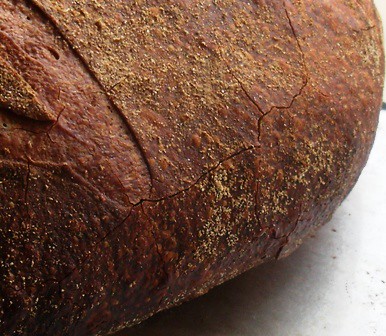



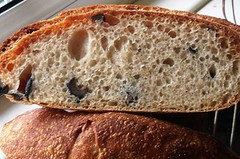
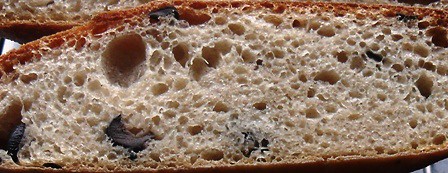

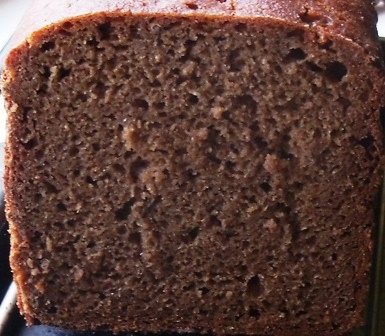




Comments
Andy, I sent a PM for you ;-)
You have been rather busy, and as always I find I am really impressed with the range of loaves you generate - not to mention their apparent quality.
Beautiful loaves, indeed.
Ron
for your kind words.
I have edited the text above to give more information about the bake profile of the first loaves.
Thank you again
Andy
I've noticed that your hearth loaves generally show significantly less bloom than I would expect. If they were my breads, I'd certainly be pleased, but I'd also think I'd pushed the limit of proofing close to "over-."
My question is whether this is planned as a matter of preferred appearance or an unplanned consequence of your oven, steaming method or other variable. If planned, is degree of proofing how you control bloom?
Andy, I'm confident you appreciate this query is in no way a criticism. I'm just seeking to understand your way of thinking about how to achieve the very consistent results you do.
Regards,
David
Hi David,
Of course, I don't take your comments as criticism, and I am very happy you have asked the question.
The Borodinsky takes over 2 hours to bake. Then the other 3 loaves take the best part of 3 hours to put through the oven one after another. So, 3 different types of breads needing different proofing conditions can be less than ideal. The Borodinsky went in the oven at 10:15am, and the last Pain de Campagne came out at 15:30. Tight, but manageable.
Open secret: I don't like home ovens, generally [especially convection]...at all! But, I really like to use only homebaked bread to satisfy household requirements; that is important to me too!
I mentioned this to Ron, just now, and I believe I've mentioned it to you before too? The hardest part of homebaking to me is the baking part. Making the dough is easy; getting the best out of the oven I find less easy. Reinhart thinks the other way round.
When you look at the crumb, I'd suggest the loaves don't show signs of over-proof. However, I agree that they can appear flat and lacking bloom.
I tend to go down this route, because going for lesser proof has led to horrible splits around the base of the loaf. So, I decided that oven spring of this type was a real turn-off, and I'd better accept full proof and no bloom. This becomes more exagerated still if I let the dough get too cold by employing considerable degree of retarding.
Oh for an electric deck oven with real power and steam injection...and NO fans!
Very Best wishes
Andy
Production scheduling seems such a necessary skill for the professional and necessary only for the home baker who bakes multiple breads/pastries/cakes on a single day. I first encountered this early in my home baking in the back of Greenstein's "Secrets of a Jewish Baker." He provides a number of baking day schedules, usually with a mix of breads and desserts.
Your answer regarding proofing was my supposition, and I fully appreciate your decision. While many like the "rustic" appearance of a loaf with chaotic bloom, I confess to preferring symmetry. I think this is culturally determined. Janedo, a very talented French home baker who was formally quite active on TFL, remarked on the American preference for "perfect," symmetrical loaves and said this was very different from the appearance preferred by the French.
David
Hi David,
I admitted to flat appearance and a lack of bloom. But I suggest "chaotic" is an over-exageration. Even "rustic" seems harsh. The blade I used needed replacing when I came to the olive levain. But the crumb of both these loaves is high quality [must be as my wife says so, and she's never wrong!] and the crust of the Pain de Campagne is first class. The photography is not always quite up to the mark in this post, however!
I kind of know what you are saying. But, I'm not seeing rustic here. And, taste will always rule supreme over symmetrical appearance, as I am sure you will agree. Both the wheaten leaven breads taste fantastic, and I have a witness [although she is very biassed, of course!]
Very best wishes
Andy
I apparently communicated poorly. I was contrasting your breads with rustic-appearing loaves.
David
...I seem to have mis-interpreted what you were really saying in that final paragraph of your previous post.
I should read your comments more carefully.
Best wishes
Andy
Hi Daisy_A,
yes, I'm really pleased with certain aspects of all these 3 breads.
Actually, the borodinsky went straight into the freezer before it was time for tasting. The crumb was a wee bit tighter than normal. I only cut into it to grab a photo; and that scarcely did justice, so maybe I should have just frozen the loaf whole without taking the photo?
Naan breads are not easy to bake at home at all, as there is no means to replicate a tandoor, that I'm aware of, except owning your own tandoor, of course!!!
The pan you describe is a "tava", and is usually used for chapatis. These are then finished on the naked flame.
For Naan bread, I pre-heat the oven until hot. Then I pitch the flat bread onto the hot tray on my brick arrangement. The next step is to switch over to the grill setting. This means you have the residual bottom heat to bake the bread and intense top heat to colour the top quickly. Turn over as needed to stop excessive browning, and make sure the bread is positioning some distance below the grill heat so it doesn't burn instantly.
I don't think I'd be happy trying to cook chunky leavened naan breads on the stove top; these weighed c. 250g each!
All good wishes
Andy
Andy,
Thanks for posting your latest bake....Needless to say that I am impressed that you can juggle 3 different formulas all in one day.....I have only recently been able to handle 2 but it puts me precariously close to 'the edge' =:-0
Your write ups have allowed me to look at feeding yeast in an entirely new light. I know authors in various books do this but I never 'got' it reading their methods....I do 'get' it with your write-ups which are like mini-revelations to me.
Because of your sharing what you do so clearly I now feel more confident experimenting with my own leaven builds tho' I tend to go for feeds that are closer together to create a less sour taste - preference of one of my children...I have also begun to use my refrigerator to help slow down a build if the yeasties are growing faster than I anticipate. My timing isn't always accurate but I am getting there and having fun using my leaven before it reaches it's peak if I have to adjust baking schedules too.....Pressure from a bowl full of dough :-)
Anyway, these new additions look great. Especially the rye loaf.......
Take Care,
Janet
Hi Janet,
Thank you so much for your kind words, and I am really glad to read that you are learning a lot about how to look after your leavens.
I think it is important to ensure some degree of maturity in the leaven along the way, in order to build up the lactic and acetic fermenting power. But you can achieve this with multiple feeds along the way, then taking your final leaven a little "green".
You live in a very hot part of the world too, no? So you can look to plenty of leavening power from a relatively low proportion of leaven in the formula. That reduces sourness; not such an obvious tactic to use here in the UK at all times!
The rye loaf?....I have to say I've made a lot better than this particular specimen, but it's fine considering it is made with 100% Dark Rye.
Very best wishes
Andy
Your breads look wonderful. You mentioned that it was more challenging to do the Borodinsky with dark rye - I didn't realize that dark rye was harder to bake with than whole rye. I love the top picture with the breads and baskets and tiles and the muted disciplined pallette. It seems to reflect the discipline that goes into making these breads with such high quality consistency month in and month out. -Varda
Hi Varda,
The challenge of the Borodinsky is really more in the eating, when made with all Dark Rye. There is little difference in working with this formula and one which uses wheat upto 20% strong white flour, or using Light Rye, except for the obvious difference in realistic volume expectation through proof and baking to finished loaf.
Dark Rye seems to be obtained from the outer parts of the rye berry. I'm not expert enough to know if that means it is a by-product [or, partial, at least] of producing white rye flour. But this is a possibility. White Rye is something I have used only once, and that was about 20 years ago. I do believe the extraction rate falls below 50%, so using the by-product as a component part of Dark Rye is a possible option, I suggest.
You are overly kind about the photography! Khalid helpfully suggested sometime ago that I cut out using flash in the photography a few months back. I was so pleased with the outdoor photo shots I achieved recently thanks to his help, but the weather was abominable all day yesterday. Of course, the shot you refer to was the only 2 minutes we saw the sun all day!!!
Really good to hear from you
Thanks
Andy
Excuse me for extremely belated post on this thread.
Re: Dark/Light Rye
I understand, from other posts by you, that you use Shipton's rye flour. If dark/light rye you're talking about in above post is that of theirs, 'dark rye' seems to be rye equivalent of wholemeal wheat flour, milled from wholegrain, and light rye being the equivalent of white flour, milled after removing the outer parts of rye berries. When I started buying flours from Shipton, I didn't know which to get because I wasn't sure how they're different, so I rang their customer desk, this is what their miller told me. In the end I ordered both of them, but to be honest the difference between Dark and Light was not as significant as you'd see in WW vs white. But I never made rye-rich bread with them, the highest proportion I've done was only 20% bakers percentage, so maybe it wasn't enough to show the difference....
Sorry, if what you're talking about was totally different, but thought I'd share what I leared from their miller if it helps.
lumos
Hi lumos,
I actually use the Bacheldre Rye Flour which is wholemeal [a recent discovery, as I actually thought it was an authentic Dark Rye, given its previously coarse and very branny appearance]. However at Village Bakery we used only Shipton Rye, both Dark and Light, so I am very familiar with the Shipton flours.
Your comment from Shipton Mill about their Dark Rye matches what they also told me; namely that their Dark Rye is also milled from the wholgrain. However, strictly, I'm not sure that is what "Dark Rye" actually is. See Hamelman, pp. 48 on this. Andrew Whitley's table in "Breadmatters" is quite useful too, pp. 78, although it isn't necessarily consistent with other sources discussing ash content and the different national systems of measurement.
Light Rye is labelled by Shipton as Type 997. This equates to a UK/US extraction rate of over 80%, so comparing it to white wheatflour does not seem at all correct. I'm sorry if that contradicts what Shipton Mill told you, but I'll happily put my neck on the line here. White Rye is around 60% extraction only!!!
See this, more recent exchange between myself, Faith and Nico here. http://www.thefreshloaf.com/node/24237/celebrating-rye-breads#comment-179110
Oh, yeah, sorry, I knew you've been using Belchdre's. I just completely mixed up with the post when you're saying to Faith you had used Shipton's dark rye before and explaining her about your experience. (yes, I've been a quiet observer to that geeky interesting discussion between you two. Very interesting, indeed...)
Is there a Type number on their packet? It's been a while since I bought flour from the, so I can't remember if I saw one on the bags. If they do, it'd be a huge help for me to find appropriate flours for me.
What I wrote above might not be completely accurate. I can't remember what the miller said exactly, but what I remember is when I asked him if dark rye was something like wholegrain flour in wheat, he replied, quite enthusiastically, 'Yes! That's exactly what it is!' But when I said, 'So the light rye is just like white wheat flour, then?' he was like, 'hmmmm...yeah.....something like that....' So, what you said about white rye extraction really explains why he was suddenly vague about it. :p
Hi lumos,
Re Type 997, see here on their website: http://www.shipton-mill.com/flour-direct-shop/rye-flours/shop-42/organic-light-rye-flour-type-997-601
I don't think Dark Rye, strictly speaking, is the same as wholemeal, even though this is what Shipton market. See Hamelman on this. As Nico has pointed out, a Dark Rye will have more of the magical aleurone layer included than would a wholemeal. The ash content in Dark Rye is even greater than it is in the 100% extraction wholegrain!
The geeky discussion is fascinating to me because I did all this stuff nearly 30 years ago brewing beer. Now I'm finding the same principles are integral to the official processes behind some of my favourite rye breads.
Best wishes
Andy
Right, OK, thanks! Why do they state Type number on only rye but not on wheat flour (except for their French style flour like Type 45 and 55) ? I really wish all the millers would tell us ash (and gluten!!) level on all white wheat flour on their bags (or at least on their website). Yeah, I know I'm sounding like a broken record player....
Until I started making bread seriously, especially sourdoughs, I hadn't really thought about the correlation between brewing and breadbaking, but of course breads hadn't existed at all if there weren't beer to start with. (and you're talking to someone who read Egyptology at uni.....The tuition fees for 4 years very well wasted) God bless, ancient Egyptian!
Please carry on with your enlightening discussion on thoser rye bread. Lovely to be able to witness how the topic is developing. :)
lumos
Lovely breads, Andy! As Varda says, there is a consistency to your breads that is very satisfying. It is difficult, even for experienced home bakers, to produce similar results (let alone the same results) on a weekly basis.
Your comment about fan ovens has piqued my interest because I have one, too and I have noticed with the fan on it burns cakes (and sometimes bread). It also dissipates steam. What is it that you don't like about fan ovens, Andy?
All the best,
Syd
Hi Syd,
It depends which oven type you want me to discuss when I express opinions about fan ovens!
So, I'll explore both.
Firstly, home ovens. I admit that I am really spoiled, having worked with top notch commercial electric deck ovens and huge wood-fired brick-built chambers. So domestic ovens are just not robust enough for me. If I pre-heat my home oven too long, then it just switches itself off. I am glad in one sense, in that I don't fancy it blowing up on me! However, if my bread is just about ready to go in the oven, then this can wreck the baking schedule.
Once, the shutdown became more permanent, so I had to remove the oven from its housing and check out the inner wiring. One of the connecting wires had burnt right through. I was staggered at the wires used; they are feeble, no wonder the oven disappoints me. Compare this to the huge 3-phase wires fitted to my oven in College, the performance is almost bound to be poor.
I have 3 bricks in the oven, and clearly the available power really struggles to cope.
So, at home, it's a lack of power, rather than an objection to fans.
Commercially, I am an unrepentant in valuing conduction over convection in the oven. I do accept that elements of conduction, convection and radiation all play their part, but direct bottom heat rules supreme for me.
The fans in the Combi Ovens we use in College are so powerful that everything burns unless the heat is turned down considerably on what you may expect. Bread made in these ovens lacks any character to me, and I find it tends to dry out too quickly as well. Heat retention within the oven is minimal.
I think you may have seen these before:
All good wishes
Andy
Thanks for that explanation, Andy. :) And, no, I hadn't seen those pics before. I am probably quite fortunate, then, as I have never worked with a commercial oven. Fortunate in the sense that I am blissfully aware of what I am missing out on! But now that you have brought it up, I would love to have the opportunity to load one of my loaves into one of those ovens. Although, ovens like those call for large batches... that would be really exciting. I have a Baumatic. I think it is a British make. I am quite satisfied with it, to be honest. It heats up rather quickly (max heat in 20 mins) although I usually preheat for somewhere between 30 and 40 if I am going to bake bread. And with my inch and a half thick local slate stone that I had custom cut, it retains it heat pretty well. It is just the fan does tend to burn the edges, like on the ear of the loaf or the points of a batard. Recently, I have been baking more with the fan off than on and I think I am happier with the results. I am still in the process of adjusting the temperatures.
Thanks for your reply, Andy.
All the best,
Syd
Yes, my oven is the same brand Syd. Unfortunately, I don't have a setting which allows me to turn the fan off!!!
Photos above: top left is my College 3 deck Tom Chandley. Photos to the right are from our Summer holiday Beach house holiday last year, complete with WFO in the garden; see here: http://www.thefreshloaf.com/node/19167/anotolika-beach-house
Bottom photo is a French gueulard oven made by companies such as Chazal. The gueulard is the "mouthpiece" which points the flames down the oven. The fires are at the front of the oven, just below, with flues coming into the oven chamber. The gueulard covers the top of the flue. There are 3 dampers at the bottom end of the oven for the heat to circulate back over the top of the brick mass, and for the smoke to escape out of the chimney above. When the oven doors are closed, the flames give rise to secondary combustion within the oven chamber as they ignite the gases which build up within. An amazing site if you can catch the flames dancing all over the oven.
The oven like this which we used at Village Bakery held 35 trays [60 x40cm], 5 deep and 7 wide! You could load around 150 - 200 large Pains de Campagne onto the sole of the oven to fill it with the setter board.
Best wishes
Andy
Well perhaps, I have a more recent model, then. Mine is only 4 years old, so still relatively new. It has five different selections. Bottom element on or both top and bottom on (with or without the fan). The fifth setting is the grill/broiler setting.
That French gueulard is a real beast. It looks like it could melt cast iron, if necessary. I should imagine oven spring is more than satisfactory with a jolt of heat like that.
Best,
Syd
Hi Syd,
We had a strap of bread tins which had become really dirty, so decided to use the oven fire as means to clean the tins.
When we came to pull the tins from the firing oven we had to pick them out one by one. The aluminium straps binding the tins together had all melted from the intensity of the fire!
There was a temperature dial on the front of the oven with a probe reading near the hottest part of the chamber at the front. The reading went round to 500*C at very nearly 6 O'Clock on the dial. We used to try to "bend the needle" to get it up to 600*C if we knew the night production schedule was particularly high!
Best wishes
Andy
Hi Andy, you gained your slice of bread even this time :-)
Finally I had the confirmation of my suspicions: your pictures of rye breads have colors shifted, probably due to lack of white balancement. That's why I often saw reddish rye crumb. The picture of this last Borodisnsky is much more alike mine.
What's your opinion about gas ovens, except that they tund to burn the bottom? They are bad beasts to tame, I guess.
Nice bread as usual!
Nico
Hi Nico,
As stated in the original blogpost, I was really disappointed with these photos. The loaf actually has all the usual reddish hue in the crust, but it does not show up so well.
We've had this bread for sandwiches the last 2 days, and I'm much more pleased with it than I expected to be. The caramelisation of those raw syrups has really come through now, and the colour of the crumb is quite wonderful, and a real contrast to the greyness of the crumb shot above.
You'll have to take my word for it here. But 'tis true!
Gas ovens? I've never used them commercially, and don't find them as good as electric ovens for the home baker.
Many thanks for your usual kind comments.
Best wishes
Andy